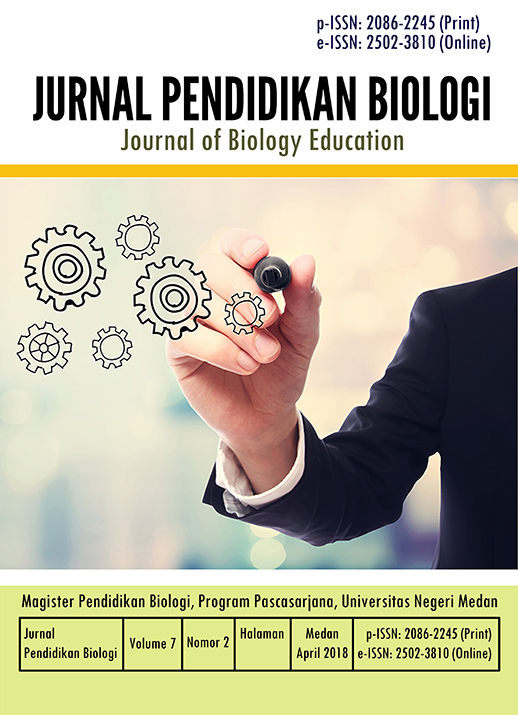Identify Causes Students Against Misconceptions in SMA Biology Material As Langsa
DOI:
https://doi.org/10.24114/jpb.v7i2.10624Abstract
Misconception is the notion of a concept that is not right, wrong in using the concept of the name, one of the concepts classify examples, doubts about the different concepts, not right in connecting a wide range of concepts in the hierarchy composition or manufacture of a generalization of the concept of excessive or less clear. This study aims to determine how much misconceptions and identify the factors that cause misconceptions students of class XI against biological materials in SMA as Langsa. This research was conducted in SMA as Langsa. The population in this study were all students of class XI Science SMAN as Langsa. Sampling technique in this study conducted stratified random sampling, so the sample used was 210 students. This study used research instrument in the form of two-dimensional diagnostic tests, questionnaires and interviews. The results showed that the percentage of students' misconceptions of the material in high school biology class XI as Langsa State is 21%. The factors that cause student misconceptions that book 24.90%, 3.34% teachers, parents 0.83%, 12.80% friends, internet 1.63%, 0.10% beliefs, and others that students responded by reading the student worksheet (LKS) or by believing in yourself by 56.39%.References
Berg, E. V. 1991. Miskonsepsi Fisika dan Remidiasi. Salatiga: UKSW.
Clement, J. 1982. Student Preconception in Introductory Mechanics. American Journal of Physics, 50: 66-71.
Fowler, M. 1998. Projectile motion. Retrieved 1.7.2..2 from The Word Wide Web http:/www.phys.virginia.edu/classes/109N/morestuff/Applets/ProjectileMotion/applet.html. diakses 15 Maret 2013.
Novak, J. D. & Canas, A. 2004. Building on new contructivist ideas and cmap tools to create a new model for education. Proceedings of the First Int. Conference on Concept Mapping, Pamplona, Spain. 1st June.
Osborne, R. J., & Wittrock, M. 1983. Learning science: A generative process. Science education. 67(4): 489-508.
Suryanto, A. & Hewindawati, Y. 2004. Pemahaman Murid Sekolah Dasar terhadap Konsep IPA Berbasis Biologi: Suatu Diagnosis Adanya Miskonsepsi. jurnal Pendidikan, 5(1): 61-72.
Tekkaya, C. 2002. Misconceptions as barrier to understanding biology. Journal of Hacettepe University Education Faculty, 23: 259-266.
Yip, D. Y. 1998. Alternative Conceptions on Excretion and Implications for Teaching. Education Journsl, 26(1): 101-116.
Yusuf, Muhammad. 2004. Analisis Miskonsepsi Siswa SLTP Negeri pada Pembelajaran Konsep Fungsi Alat Tubuh Tumbuhan. Tesis Magister PPS UPI Bandung.
Downloads
Published
Issue
Section
License
Copyright
Penyerahan naskah menyiratkan bahwa karya yang diserahkan belum pernah diterbitkan sebelumnya (kecuali sebagai bagian dari tesis, laporan, atau abstrak). Naskah tidak dipertimbangkan untuk publikasi di tempat lain. Penerbitannya telah disetujui oleh semua penulis bersama. Jika dan kapan naskah diterima untuk publikasi, penulis masih memegang hak cipta dan mempertahankan hak penerbitan tanpa batasan. Penulis atau orang lain diperbolehkan untuk melipatgandakan artikel selama tidak untuk tujuan komersial. Untuk penemuan baru, penulis disarankan untuk mengelola patennya sebelum diterbitkan.
Open Access
Jurnal ini berkomitmen untuk membuka akses bebas yang tidak membebankan biaya kepada pembacanya atau lembaga mereka. Pembaca berhak membaca, mengunduh, menyalin, mendistribusikan, mencetak, mencari, atau menautkan ke teks lengkap artikel, selama tidak untuk tujuan komersial. Jenis lisensi adalah CC-BY-4.0.
Disclaimer
Tidak ada tanggung jawab yang dikenakan kepada Penerbit atau oleh editor untuk kesalahan dan/atau kerusakan pada naskah sebagai akibat dari pernyataan pencemaran nama baik atau dugaan pencemaran nama baik, pelanggaran hak kekayaan intelektual atau privasi, atau kewajiban produk, baik akibat kelalaian atau sebaliknya, atau dari penggunaan atau operasi ide, instruksi, prosedur, produk atau metode apa pun yang terkandung dalam materi di dalamnya.

